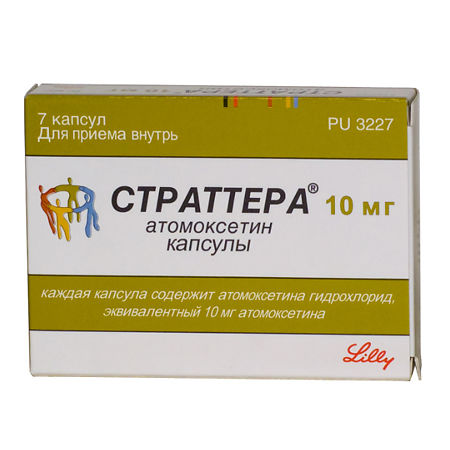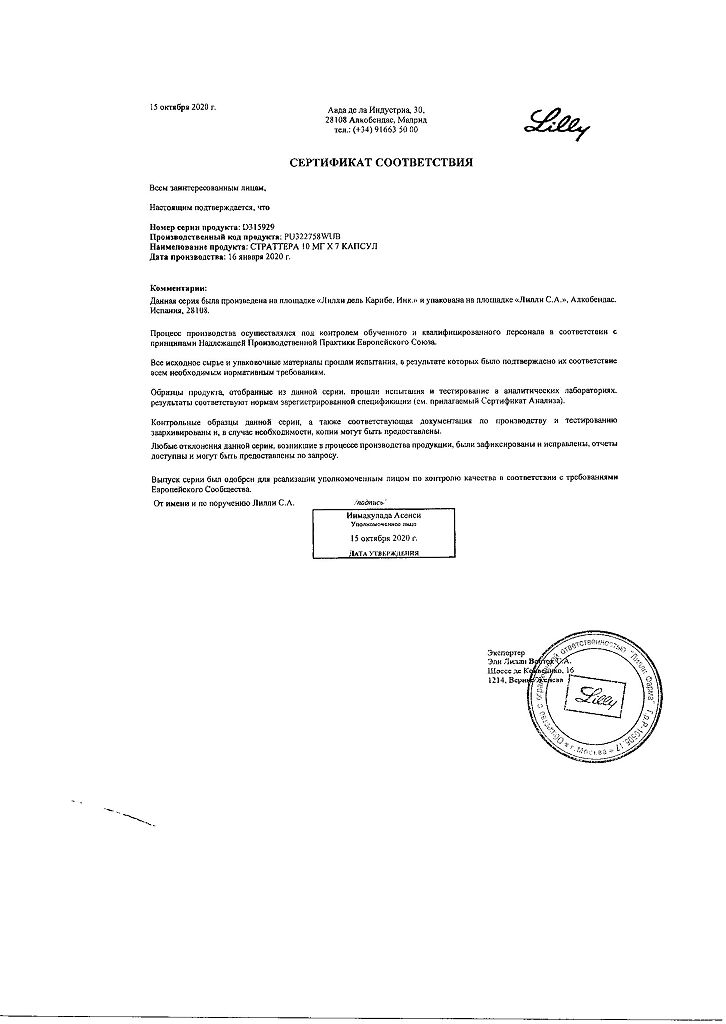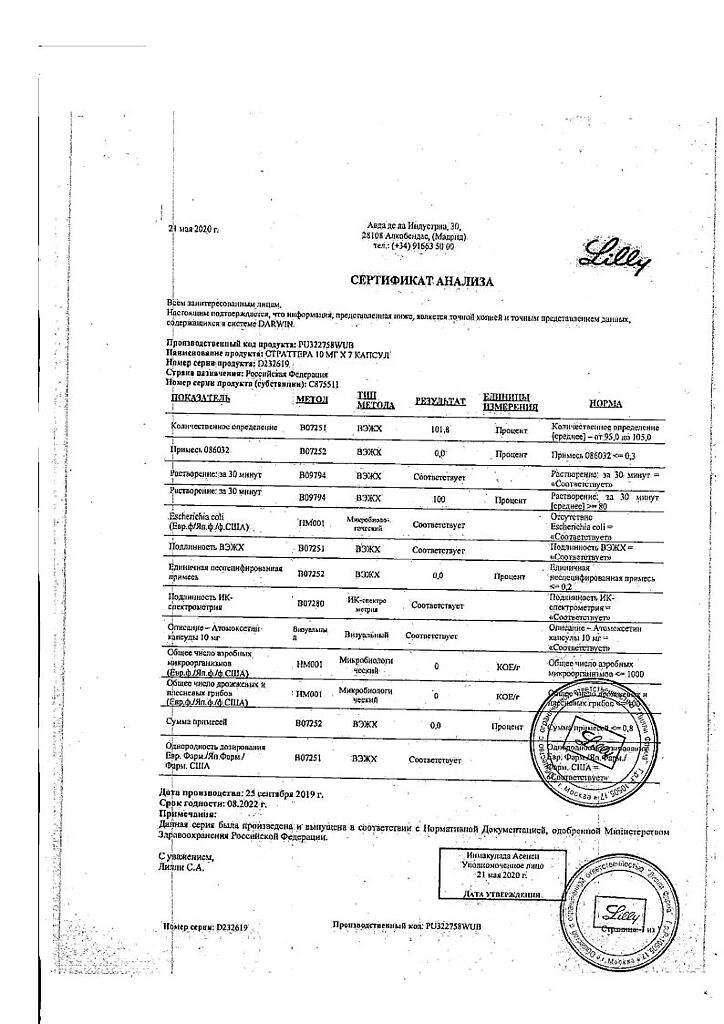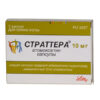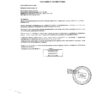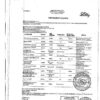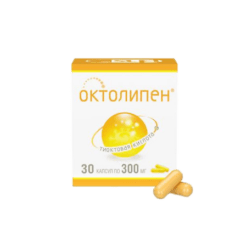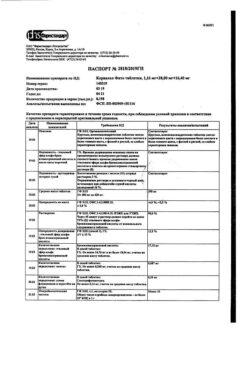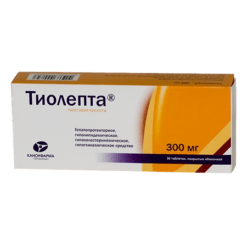No products in the cart.
Strattera, 10 mg capsules 7 pcs
€52.44 €43.70
Description
Pharmacodynamics
Atomoxetine is a highly selective potent inhibitor of presynaptic noradrenaline transporters. Atomoxetine has minimal affinity for other noradrenergic receptors or other neurotransmitter transporters or receptors.
Atomoxetine is not a psychostimulant and is not an amphetamine derivative. No increase in disease symptoms or adverse events related to withdrawal have been seen in clinical studies.
Pharmacokinetics
Pharmacokinetics in children and adolescents are similar to pharmacokinetics in adults. The pharmacokinetics of atomoxetine in children under 6 years of age have not been studied.
Intake. Atomoxetine is rapidly and almost completely absorbed after oral administration, reaching maximum plasma concentration (Cmax) in approximately 1 to 2 hours. Atomoxetine is prescribed regardless of meals or with meals.
Distribution. Atomoxetine is well distributed in the body. Atomoxetine has a high affinity for plasma proteins, primarily albumin.
Metabolism. Atomoxetine is primarily biotransformed through the cytochrome P450 2D6 (CYP2D6) enzyme cycle. The main resulting oxidized metabolite, 4-hydroxyatomoxetine, is rapidly glucuronized. 4-Hydroxyatomoxetine is equivalent in action to atomoxetine, but circulates in the plasma at much lower concentrations.
While 4-hydroxyatomoxetine is primarily formed by CYP2D6, in people with insufficient CYP2D6 activity 4-hydroxyatomoxetine can be formed by some other cytochrome P450 enzymes, but more slowly.
Atomoxetine does not inhibit or enhance the CYP2D6 cycle.
Extraction.
The average half-life of atomoxetine after oral administration is 3.6 hours in patients with significant metabolism and 21 hours in patients with decreased metabolism. Atomoxetine is mainly excreted in the urine as 4-hydroxyatomoxetine-O-glucuronide.
Indications
Indications
Attention deficit hyperactivity disorder (ADHD) in children 6 years of age and older, adolescents and adults.
Pharmacological effect
Pharmacological effect
Pharmacodynamics
Atomoxetine is a highly selective, potent inhibitor of presynaptic norepinephrine transporters. Atomoxetine has minimal affinity for other noradrenergic receptors or other neurotransmitter transporters or receptors.
Atomoxetine is not a psychostimulant and is not an amphetamine derivative. In clinical studies, when discontinuing the drug, there was no increase in symptoms of the disease or any adverse events associated with withdrawal syndrome.
Pharmacokinetics
Pharmacokinetics in children and adolescents is similar to pharmacokinetics in adults. The pharmacokinetics of atomoxetine in children under 6 years of age has not been studied.
Suction. Atomoxetine is rapidly and almost completely absorbed after oral administration, reaching its maximum concentration (Cmax) in plasma after approximately 1 to 2 hours. Atomoxetine is prescribed regardless of meals or with meals.
Distribution. Atomoxetine is well distributed in the body. Atomoxetine has a high affinity for plasma proteins, primarily albumin.
Metabolism. Atomoxetine primarily undergoes biotransformation through the enzyme cycle of cytochrome P450 2D6 (CYP2D6). The main oxidized metabolite formed, 4-hydroxyatomoxetine, is rapidly glucuronidated. 4-hydroxyatomoxetine is equivalent in action to atomoxetine, but circulates in plasma at much lower concentrations.
Although 4-hydroxyatomoxetine is primarily formed by CYP2D6, in people with insufficient CYP2D6 activity, 4-hydroxyatomoxetine can be formed by some other cytochrome P450 enzymes, but more slowly.
Atomoxetine does not inhibit or enhance the CYP2D6 cycle.
Excretion.
The average half-life of atomoxetine after oral administration is 3.6 hours in patients with advanced metabolism and 21 hours in patients with reduced metabolism. Atomoxetine is primarily excreted in urine as 4-hydroxyatomoxetine-O-glucuronide.
Special instructions
Special instructions
ADHD symptoms of impaired attention and hyperactivity (identified in more than one social environment, such as both home and school) may manifest as lack of concentration, distractibility, excessive impatience, impulsivity, disorganization, restlessness, and other similar behavioral problems. The diagnosis of ADHD must meet the ICD-10 criteria.
Suicidal thoughts and behavior. While taking the drug in clinical studies in children and adolescents, the likelihood of developing suicidal thoughts increased. In 12 clinical studies in 2,200 patients (including 1,357 patients receiving atomoxetine and 851 patients receiving placebo), suicidal thoughts were detected in the atomoxetine group in 0.37% of cases (5 out of 1,357 patients); suicidal thoughts were not detected in the placebo group. During these clinical studies, one suicide attempt was reported and there were no completed suicides.
Allergic reactions. In rare cases, patients taking atomoxetine have experienced allergic reactions in the form of rash, angioedema, and urticaria.
Monoamine oxidase inhibitors (MAO inhibitors). Atomoxetine should not be used for at least 2 weeks after discontinuation of MAOIs. Treatment with MAOIs should not be started within 2 weeks after discontinuation of atomoxetine. Cardiovascular system. Many patients taking atomoxetine experienced a slight increase in heart rate (on average by
acquired prolongation of the QT interval.
With the use of psychostimulants registered for the treatment of ADHD in the United States in children with severe heart pathology that disrupts its structure, an increased risk of sudden cardiac death has been identified. Atomoxetine does not belong to the class of psychostimulants, as it has an alternative mechanism of therapeutic action in the treatment of ADHD. However, given the general registered indication for use (ADHD), caution should be exercised when using atomoxetine in patients with: (1) severe physical exertion, (2) concomitant use of psychostimulants, (3) family history of sudden cardiac death. Atomoxetine should not be used in patients with severe cardiac pathology.
Impaired liver or kidney function. Rare cases of serious liver damage have been reported with atomoxetine (two cases of marked increases in liver enzymes and bilirubin in 2 million patients have been reported). In patients with manifestations of jaundice or laboratory findings indicating impaired liver function, treatment with atomoxetine should be discontinued.
In clinical trials, adult patients with ADHD taking atomoxetine experienced a higher incidence of urinary retention compared with placebo. Complaints of urinary retention could potentially be regarded as a result of the use of atomoxetine.
Use with caution in patients with a history of seizures. It is necessary to stop taking atomoxetine if seizures develop that cannot be explained by other reasons.
Use in children. There is insufficient data on the safety and effectiveness of atomoxetine in children under 6 years of age.
The effectiveness of treatment with atomoxetine for more than 18 months and the safety of treatment for more than 2 years have not been systematically assessed.
Use in the elderly. The safety and effectiveness of atomoxetine in elderly patients has not been established.
Aggressive behavior or hostility. Aggressive behavior or hostility is often observed in children and adolescents with ADHD. There is no conclusive evidence that atomoxetine can cause aggressive behavior or hostility. However, in clinical studies, aggressive behavior or hostility was observed more often in children and adolescents taking atomoxetine (without statistically significant differences compared with the placebo group). Patients receiving treatment for ADHD should be monitored for aggressive behavior or hostility.
Psychotic and manic symptoms.
Cases of psychotic and manic symptoms, including hallucinations, delusions and pathological elevation of mood, are known to occur during the use of atomoxetine in therapeutic doses in children and adolescents. If these symptoms occur, it is recommended to assess the degree of their connection with taking atomoxetine and, if necessary, consider discontinuing the drug.
The following symptoms have been noted while taking atomoxetine: anxiety, agitation, panic attacks, insomnia, irritability, impulsivity, akathisia. Patients taking atomoxetine should be monitored by a physician for the development of these symptoms.
Parents and loved ones should carefully monitor the occurrence of all of the above symptoms and suicidal thoughts in children and adolescents taking atomoxetine and immediately report this to their doctor.
Driving a car and performing work that requires increased attention
Taking the drug may be accompanied by drowsiness. Therefore, patients taking atomoxetine should use caution when operating hazardous mechanical equipment, including a motor vehicle, until they are confident that atomoxetine is not causing any impairment.
Active ingredient
Active ingredient
Atomoxetine
Composition
Composition
Each capsule contains:
active substance:
atomoxetine hydrochloride,
equivalent to 10 mg atomoxetine;
excipients:
contents of the capsule – dimethicone,
pregelatinized starch;
capsule shell – titanium dioxide,
sodium lauryl sulfate,
gelatin.
Pregnancy
Pregnancy
Due to insufficient experience with the use of atomoxetine during pregnancy, the drug should be prescribed during pregnancy only if the potential benefit to the patient significantly outweighs the potential risk to the fetus.
It is not known whether atomoxetine is excreted in breast milk. Caution must be exercised when prescribing the drug to a nursing woman.
Contraindications
Contraindications
Hypersensitivity to the drug
Concomitant use with monoamine oxidase inhibitors (MAOIs)
Angle-closure glaucoma
Severe heart damage
With caution
In patients with hypertension, tachycardia, cardiovascular disease, severe physical overload, concomitant use of psychostimulants, sudden cardiac death in a family history, cerebrovascular accident, history of seizures, as well as in conditions that can lead to hypotension
Side Effects
Side Effects
Children and teenagers
From the digestive system: very often (>10%) – abdominal pain (18%; including symptoms of abdominal discomfort, pain and discomfort in the epigastrium, discomfort in the stomach), loss of appetite (16%), vomiting (11%); often (1–10%) – constipation, dyspepsia, nausea (9%), anorexia. These adverse reactions are temporary and, as a rule, do not require discontinuation of the drug.
Due to decreased appetite, some patients experienced a decrease in body weight at the beginning of treatment (on average about 0.5 kg), weight loss was greater at higher doses. After an initial decrease in body weight, patients taking Strattera experienced a slight increase in body weight with long-term therapy. Growth indicators (weight and height) after two years of treatment were close to normal.
Nausea (9%) and vomiting (11%) are most likely to occur during the first month of treatment, are usually mild to moderate, are temporary, and do not cause discontinuation of treatment in a significant number of cases.
From the cardiovascular system: (0.1–1%) – palpitations, sinus tachycardia.
In placebo-controlled studies, children receiving Strattera experienced a mean increase in heart rate of 6 beats/min and a mean increase in SBP and DBP of 2 mmHg. compared to placebo.
Patients receiving atomoxetine experienced orthostatic hypotension (0.2%, n=7) and syncope (0.8%, n=26), due to its effect on noradrenergic tone.
From the side of the central nervous system: very often (>10%) – drowsiness (including sedation); often (1–10%) – irritability, mood swings, dizziness; sometimes (0.1–1%) – early morning awakening.
On the part of the organ of vision: often (1–10%) – mydriasis.
Dermatological reactions: often (1–10%) – dermatitis, rash; sometimes (0.1–1%) – itching.
Other: often (1–10%) – flu, fatigue, weight loss; sometimes (0.1–1%) – weakness.
Side effects in patients with slow metabolism of CYP2D6 substrates, observed in 2% of cases and 2 times more often, and also statistically significantly more often than in patients with rapid metabolism of CYP2D6 substrates: tremor (5.1 and 1.1%, respectively), fainting (2.1 and 0.7%, respectively), conjunctivitis (3 and 1.5%, respectively), early morning awakening (3 and 1.1%, respectively), mydriasis (2.5 and 0.7%, respectively).
Adults
In adults, the most common side effects associated with taking atomoxetine were the gastrointestinal and urogenital tract. No serious adverse events were observed during short or long-term treatment with atomoxetine.
From the digestive system: very often (>10%) – loss of appetite, dry mouth, nausea; often (1–10%) – abdominal pain (including symptoms of abdominal discomfort, pain and discomfort in the epigastrium, discomfort in the stomach), constipation, dyspepsia, flatulence.
From the side of the central nervous system: very often (>10%) – insomnia (includes difficulty falling asleep and sleep disturbances in the middle of the night); often (1–10%) – decreased libido, dizziness, impaired sleep quality, sinus headache; sometimes (0.1–1%) – early morning awakening.
From the cardiovascular system: often (1–10%) – flushing of the face, palpitations, tachycardia; sometimes (0.1–1%) – a feeling of cold in the lower extremities.
In placebo-controlled studies, adults treated with Strattera experienced a mean increase in heart rate of 6 beats/min and a mean increase in sBP (about 3 mmHg) and dBP (about 1 mmHg) compared to placebo.
From the urinary system: often (1–10%) – dysuria, difficulty urinating.
From the reproductive system: often (1–10%) – dysmenorrhea, ejaculation disorders, lack of ejaculation, erectile dysfunction, erectile dysfunction, menstrual irregularities, orgasm disorders; very rarely (
From the skin and subcutaneous tissue: often (1–10%) – dermatitis, increased sweating.
Other: often (1–10%) – weakness, drowsiness, chills, weight loss.
Interaction
Interaction
Beta-adrenergic receptor agonists.
Atomoxetine should be used with caution in patients taking beta2 agonists, as their effects on the cardiovascular system may be increased. In adult healthy volunteers, the effect of the drug salbutamol in a standard inhaled dose of 200 mcg on hemodynamic parameters was insignificant compared to the effect of the indicated dose of this drug when administered intravenously.
Concomitant use of atomoxetine at a dose of 80 mg/day for 5 days did not increase these effects of albuterol. Heart rate after repeated inhalations of albuterol at a dose of 800 mcg was characterized by similar values in both monotherapy and in combination with atomoxetine. Co-administration of atomoxetine with drugs that cause prolongation of the QT interval (neuroleptics, antiarrhythmic drugs, moxifloxacin, erythromycin, tricyclic antidepressants, lithium carbonate), as well as with drugs that cause electrolyte imbalance (diuretics) and CYP2D6 inhibitors increases the risk of prolongation of the QT interval.
Cytochrome P450 enzymes. Atomoxetine does not cause clinically significant suppression or induction of cytochrome P450 enzymes, including CYP1A2, CYP3A, CYP2D6 and CYP2C9. In patients who are significant CYP2D6 metabolizers, CYP2D6 inhibitors increase the steady-state plasma levels of atomoxetine to levels similar to those in patients who are poor CYP2D6 metabolizers.
In vitro studies suggest that administration of cytochrome P450 inhibitors to patients who are poor CYP2D6 metabolizers does not increase plasma concentrations of atomoxetine. For patients using CYP2D6 inhibitor drugs, gradual titration of atomoxetine is recommended.
Drugs that affect blood pressure. Due to the possible effect on blood pressure, atomoxetine should be used with caution when combined with drugs that affect blood pressure.
Drugs that affect the acidity of gastric juice. Drugs that increase the pH of gastric juice (magnesium hydrochloride/aluminum hydroxide, omeprazole) do not affect the biological absorption of atomoxetine.
Drugs that affect the secretion of norepinephrine. Drugs that affect the secretion of norepinephrine should be administered with caution with atomoxetine due to the possibility of enhanced or synergistic pharmacological effects.
Drugs with high affinity for plasma proteins. Atomoxetine does not affect the binding of warfarin, acetylsalicylic acid, phenytoin and diazepam to human albumin.
Drugs with a known effect of lowering the seizure threshold
(antidepressants, antipsychotics, mefloquine, tramadol). Caution must be exercised during coadministration.
Overdose
Overdose
Signs and symptoms. The most common symptoms in acute and chronic overdose with atomoxetine monotherapy were drowsiness, agitation, hyperactivity, behavioral disturbances and gastrointestinal symptoms. Most manifestations were mild to moderate in severity.
Signs and symptoms of mild to moderate activation of the sympathetic nervous system (eg, mydriasis, tachycardia, dry mouth) have also been noted. All patients showed regression of these symptoms. In some cases, convulsions have been observed with an overdose of atomoxetine. Cases of fatal acute overdose have also been reported when atomoxetine was taken in combination with at least one other drug.
Treatment for overdose. Ventilation, cardiac and vital sign monitoring, and symptomatic and supportive treatment are recommended. Gastric lavage may be indicated if not much time has passed after taking the drug.
Activated charcoal may be helpful to limit absorption. Since atomoxetine has a high affinity for plasma proteins, treatment of overdose by dialysis is likely to be inappropriate.
Storage conditions
Storage conditions
At 15–25 °C
Shelf life
Shelf life
3 years
Manufacturer
Manufacturer
Lilly del Caribe Inc., Puerto Rico
Additional information
| Shelf life | 3 years |
|---|---|
| Conditions of storage | At 15-25 °C |
| Manufacturer | Lilly del Caribe Inc., Puerto Rico |
| Medication form | capsules |
| Brand | Lilly del Caribe Inc. |
Other forms…
Related products
Buy Strattera, 10 mg capsules 7 pcs with delivery to USA, UK, Europe and over 120 other countries.

